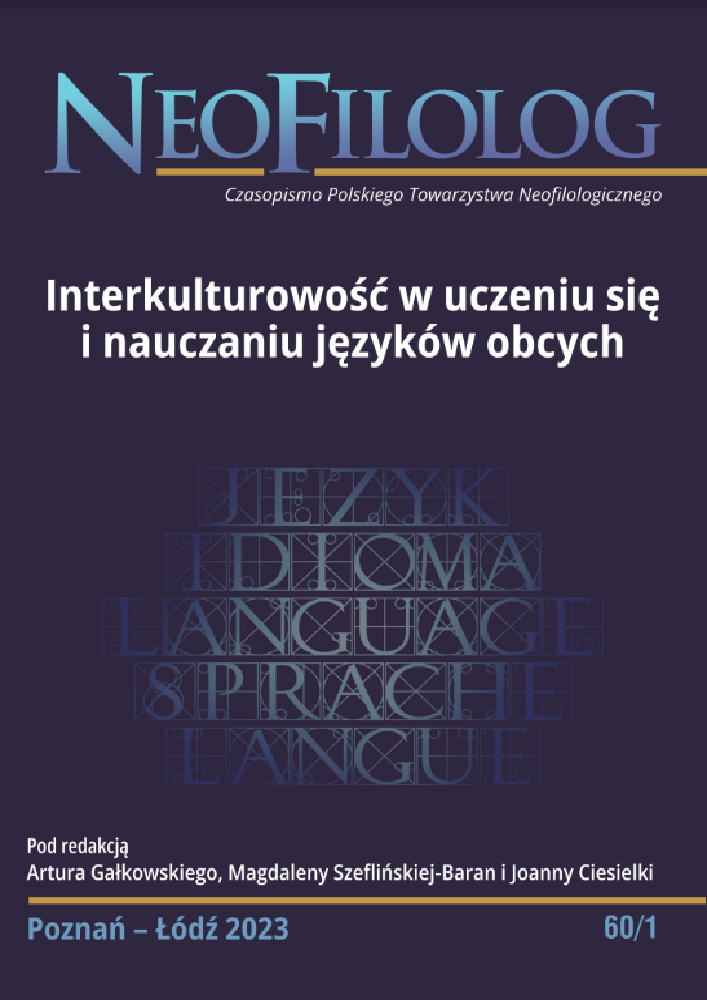Abstract
The shift to distance learning in foreign languages teaching has further emphasized the need for communication and interaction set in a context close to authentic experience. The starting point of the research was the assumption that a new classroom practice developed during the pandemic –the “language space bridge” – contributes to the development of language education and influences the improvement of intercultural competence. This article is based on a study of the “language space bridge”, a non-institutional educational platform running between 2020 and 2022 and set up by an international team of foreign language teachers collaborating under an Erasmus+ project. The article discusses theoretical aspects of intercultural communication and forms of training. A description of the research process is followed by the presentation of the didactic process itself. Having conducted an in-depth analysis of the evaluation questionnaires completed by the students and teachers, the authors conclude that the new educational platform might be a way to improve intercultural competence for both students and teachers.
Literaturhinweise
Aleksandrowicz-Pędich L. (2007), Interkulturowość w kształceniu językowym w Polsce i innych krajach europejskich, (w:) Nauczanie języków obcych – Polska a Europa (red. Komorowska H.), Warszawa: Wydawnictwo SWPS, s. 39–56.
Bandura E. (2007), Nauczyciel jako mediator kulturowy. Kraków: Wydawnictwo Tertium.
Byram M., Zarate G. (1994), Definitions, objectives and assessment of socio-cultural competence. Strasbourg: Council of Europe.
Byram M. (1997), Teaching and Assessing Intercultural Communicative Competence. Clevedon: Multilingual Matters.
Chomsky N. (1957), Syntactic structures. Hague: Mouton & Co. DOI: https://doi.org/10.1515/9783112316009
ESOKJ-Europejski system kształcenia językowego: uczenie się, nauczanie, ocenianie (2001), Warszawa: CODN.
ESOKJ-Europejski system kształcenia językowego: uczenie się, nauczanie, ocenianie (2020): online: https://rm.coe.int/common-european-framework-of-reference-for-languages-learning-teaching/16809ea0d4 [DW 26.07.2022].
Grucza F. (1976), Lingwistyczne uwarunkowania glottodydaktyki, (w:) Grucza F. (red.), Glottodydaktyka a lingwistyka. Warszawa: Wydawnictwo Uniwersytetu Warszawskiego, s. 7–25.
Grucza F. (1992), Kulturowe determinanty języka oraz komunikacji językowej, (w:) Grucza F. (red.), Język, kultura – kompetencja kulturowa. Materiały z XII Sympozjum ILS UW (Zaborów, 5-8 listopada 1987). Warszawa: Wydawnictwa Uniwersytetu Warszawskiego, s. 9-70.
Mihułka K. (2014), Dylematy współczesnej glottodydaktyki: język – kultura, interlingwalizm – interkulturowość. „Języki Obce w Szkole”, nr 3, s. 78-87.
Mihułka K. (2012a), Rozwój kompetencji interkulturowej w warunkach szkolnych. Mity a polska rzeczywistość. Rzeszów: Wydawnictwo Uniwersytetu Rzeszowskiego.
Mihułka K. (2012b), Sposoby rozwijania kompetencji interkulturowej na lekcji języka obcego. „Języki Obce w Szkole”, nr 2, s. 106-117.
Matsumoto D., Yoo S. H. (2006), Toward a new generation of cross-cultural research. „Perspectives on Psychological Sciences”, nr 1(3), s. 234–250. DOI: https://doi.org/10.1111/j.1745-6916.2006.00014.x
Róg T. (2017), Teoria w pigułce. Zestaw 10. Zeszyt 1, online: http://www.bc.ore.edu.pl/Content/996/JO_10_1.pdf [DW 09.01.2023].
Sapir E. (1921), Language: An Introduction to The Study of Speech. New York: Harcourt, Brace & World Inc.
Siek-Piskozub T. (2012), Międzykulturowa kompetencja komunikacyjna wyzwaniem dla glottodydaktyki. „Lingwistyka Stosowana”, nr 5, s. 95–108.
Wilczyńska W. (2005), Czego potrzeba do udanej komunikacji interkulturowej, (w:) Mackiewicz M. (red), Dydaktyka języków obcych a kompetencja kulturowa i komunikacja interkulturowa. Poznań: Wydawnictwo Wyższej Szkoły Bankowej, s. 15-27.
Wilczyńska W., Mackiewicz M., Krajka J. (2019), Komunikacja interkulturowa. Wprowadzenie. Poznań: Wydawnictwo Naukowe UAM.
Lizenz
Copyright (c) 2023 Marta Wojakowska, Wojciech Sosnowski

Dieses Werk steht unter der Lizenz Creative Commons Namensnennung - Keine Bearbeitungen 4.0 International.
Autoren:
Die Autoren der zur Veröffentlichung in der Zeitschrift Neofilolog angenommenen Texte sind verpflichtet, den Vertrag über die Erteilung einer kostenlosen Lizenz für die Werke mit der Verpflichtung zur Erteilung einer Sublizenz CC auszufüllen, zu unterzeichnen und an die Adresse der Redaktion zurückzusenden.
Gemäß Vertrag erteilen die Autoren auf die in der Zeitschrift Neofilolog veröffentlichten Texte der Adam-Mickiewicz-Universität in Poznań eine nicht exklusive und kostenlose Lizenz und erlauben die Verwendung der Sublizenz Creative Commons Attribution-NoDerivatives 4.0 International (CC BY-ND 4.0).
Die Autoren behalten das Recht zur weiteren freien Verfügung über das Werk.
Benutzer:
Interessierte Onlinebenutzer dürfen die seit 2017 veröffentlichten Werke unter folgenden Bedingungen nutzen:
- Anerkennung der Urheberschaft - die Verpflichtung, zusammen mit dem verbreiteten Werk Informationen über die Urheberschaft, den Titel, die Quelle (Links zum Originalwerk, DOI) und die Lizenz selbst bereitzustellen;
- ohne Schaffung abgeleiteter Werke - das Werk muss in seiner ursprünglichen Form erhalten bleiben, ohne Zustimmung des Autors dürfen keine Studien, beispielsweise Übersetzungen, verbreitet werden.
Die Urheberrechte aller veröffentlichen Texte sind vorbehalten.
Sonstige:
Die Adam-Mickiewicz-Universität in Poznań behält das Recht auf die Zeitschrift als Gesamtheit (Layout, Grafik, Titel, Umschlagsprojekt, Logo usw.).

